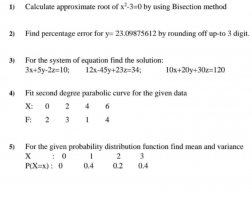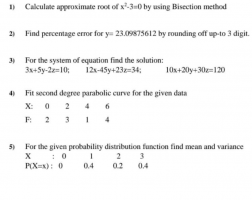You are using an out of date browser. It may not display this or other websites correctly.
You should upgrade or use an alternative browser.
You should upgrade or use an alternative browser.
Can anyone Plz sove me these questions
- Thread starter Vc8bp
- Start date
HallsofIvy
Elite Member
- Joined
- Jan 27, 2012
- Messages
- 7,763
Do you understand what these questions mean?
The first asks you to use the "bisection method" to numerically solve the equation \(\displaystyle x^3- 3= 0\). Do you understand what the "bisection method" is?
I notice that if x= 0, \(\displaystyle x^3- 3= 0- 3= -3\) which is less than 0 and that if x= 2, \(\displaystyle x^3- 3= 8- 3= 5\) which is greater than 0. Since \(\displaystyle f(x)= x^3- 3\) is a continuous function, there must be a value of x that satifies this equation between 0 and 2. We don't know where but we can try a value between. The "bisection method" bisects the interval taking a new x halfway between 0 and 2; x= 1. With x= 1, \(\displaystyle x^3- 3= 1- 3= -2\). That is negative so now we know there must be a root between 1 and 2. Halfway between is 3/2. With x= 3/2, \(\displaystyle x^3- 3= 27/8- 3= 27/8- 24/8= 3/8. That is positive so now we know that there is a root between 3/2 and the last value of x to give a negative value, x= 1. Half way between 1 and 3/2 is 5/4. Try x= 5/4 and see what happens. Continue like that until you have sufficient accuracy- perhaps until two consecutive values are within the desired accuracy.
For the second problem, "rounding to 3 digits" (NOT to "3 decimal places") gives 23.1. The "error" is the the absolute value of the actual number minus that approximation, 23.09875612-23.1, 0.00124388. The "percentage error" is that error, divided by 23.09875612, written as a percentage.
For the third problem, solving a system of three equations in three unknowns, you "manipulate" the equation, adding or subtracting multiples of one equation from another to eliminate one of the unknowns to get two equations in two unknows and then do the same to eliminate one of the remaining unknowns leaving you with a single equation to solve for the one remaining unknown.
For example, I see that the "-45" and "20" multiplying y in the second and third equations are both multiples of the "5" multiplying y in the first equation. Multiplying the first equation by 9 gives 27x+ 45y- 18z= 90. Adding that to 12x- 45y+ 23z= 34 eliminates y giving 39x+ 5z= 124. Multiplying the first equation by 4 gives 12x+ 20y- 8z= 40. Subtracting 10x+ 20y+ 30z= 120 from that gives 2x- 38z= -80. Now you have two equations in x and z. Find a way to eliminate one of those so you have one equation in one unknown. Solve that then go back and put that value into the equations 39x+ 5z= 24 or 2x- 38x= -80 to get an equation to solve for the remaining unknown, then go back and put those two values it one of the original three equations to get an equation to solve for y.
The fourth problem asks you to find a quadratic function that passes through 4 given points. You should know that any quadratic function can be written in the form f(x)= ax^2+ bx+ c for some values of a, b, and c. Putting in three of the give "x and f" values gives us three equations to solve for a, b, and c. Here we are told that when x= 0, f(x)= 2 so 2= a(0^2)+ b(0)+ c= c= 2. When x= 2, f(x)= 3 so 3= a(2^2)+ b(2)+ c= 4a+ 2b+ c. And when x= 4, f(x)= 1 so 1= a(4^2)+ b(4)+ c= 16a+ 4b+ c.
Solve the three equations
c= 2
4a+ 3b+ c= 3 and
16a+ 4b+ c= 1
for a, b, and c.
We are also told that f(6)= 4. Use that as a check.
Problem 5 asks you to find the mean and variance of a probability distribution. Do you know the definitions of "mean" and "variance"? If not, look them up! The definitions will tell you how to calculate them.\)[/tex][/tex]
The first asks you to use the "bisection method" to numerically solve the equation \(\displaystyle x^3- 3= 0\). Do you understand what the "bisection method" is?
I notice that if x= 0, \(\displaystyle x^3- 3= 0- 3= -3\) which is less than 0 and that if x= 2, \(\displaystyle x^3- 3= 8- 3= 5\) which is greater than 0. Since \(\displaystyle f(x)= x^3- 3\) is a continuous function, there must be a value of x that satifies this equation between 0 and 2. We don't know where but we can try a value between. The "bisection method" bisects the interval taking a new x halfway between 0 and 2; x= 1. With x= 1, \(\displaystyle x^3- 3= 1- 3= -2\). That is negative so now we know there must be a root between 1 and 2. Halfway between is 3/2. With x= 3/2, \(\displaystyle x^3- 3= 27/8- 3= 27/8- 24/8= 3/8. That is positive so now we know that there is a root between 3/2 and the last value of x to give a negative value, x= 1. Half way between 1 and 3/2 is 5/4. Try x= 5/4 and see what happens. Continue like that until you have sufficient accuracy- perhaps until two consecutive values are within the desired accuracy.
For the second problem, "rounding to 3 digits" (NOT to "3 decimal places") gives 23.1. The "error" is the the absolute value of the actual number minus that approximation, 23.09875612-23.1, 0.00124388. The "percentage error" is that error, divided by 23.09875612, written as a percentage.
For the third problem, solving a system of three equations in three unknowns, you "manipulate" the equation, adding or subtracting multiples of one equation from another to eliminate one of the unknowns to get two equations in two unknows and then do the same to eliminate one of the remaining unknowns leaving you with a single equation to solve for the one remaining unknown.
For example, I see that the "-45" and "20" multiplying y in the second and third equations are both multiples of the "5" multiplying y in the first equation. Multiplying the first equation by 9 gives 27x+ 45y- 18z= 90. Adding that to 12x- 45y+ 23z= 34 eliminates y giving 39x+ 5z= 124. Multiplying the first equation by 4 gives 12x+ 20y- 8z= 40. Subtracting 10x+ 20y+ 30z= 120 from that gives 2x- 38z= -80. Now you have two equations in x and z. Find a way to eliminate one of those so you have one equation in one unknown. Solve that then go back and put that value into the equations 39x+ 5z= 24 or 2x- 38x= -80 to get an equation to solve for the remaining unknown, then go back and put those two values it one of the original three equations to get an equation to solve for y.
The fourth problem asks you to find a quadratic function that passes through 4 given points. You should know that any quadratic function can be written in the form f(x)= ax^2+ bx+ c for some values of a, b, and c. Putting in three of the give "x and f" values gives us three equations to solve for a, b, and c. Here we are told that when x= 0, f(x)= 2 so 2= a(0^2)+ b(0)+ c= c= 2. When x= 2, f(x)= 3 so 3= a(2^2)+ b(2)+ c= 4a+ 2b+ c. And when x= 4, f(x)= 1 so 1= a(4^2)+ b(4)+ c= 16a+ 4b+ c.
Solve the three equations
c= 2
4a+ 3b+ c= 3 and
16a+ 4b+ c= 1
for a, b, and c.
We are also told that f(6)= 4. Use that as a check.
Problem 5 asks you to find the mean and variance of a probability distribution. Do you know the definitions of "mean" and "variance"? If not, look them up! The definitions will tell you how to calculate them.\)[/tex][/tex]


